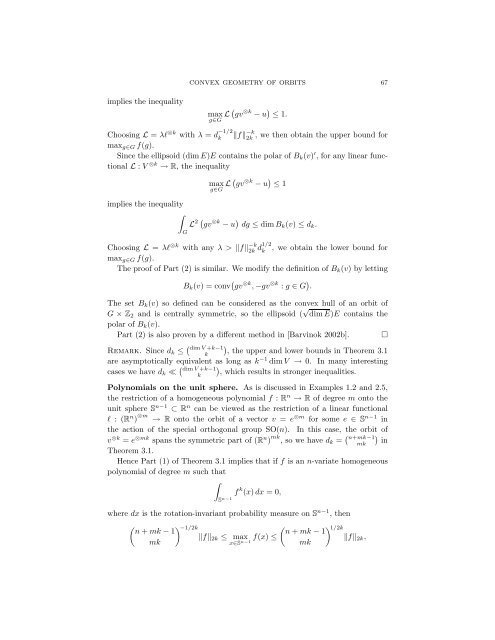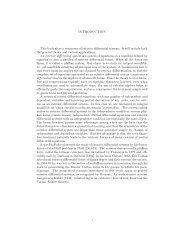Create successful ePaper yourself
Turn your PDF publications into a flip-book with our unique Google optimized e-Paper software.
implies the inequality<br />
Choosing L = λℓ ⊗k with λ = d −1/2<br />
k<br />
CONVEX GEOMETRY OF ORBITS 67<br />
max<br />
g∈G L�gv ⊗k − u � ≤ 1.<br />
�f� −k<br />
2k , we then obtain the upper bound for<br />
maxg∈G f(g).<br />
Since the ellipsoid (dim E)E contains the polar <strong>of</strong> Bk(v) ′ , for any linear functional<br />
L : V ⊗k → R, the inequality<br />
implies the inequality<br />
�<br />
max<br />
g∈G L� gv ⊗k − u � ≤ 1<br />
L<br />
G<br />
2 � gv ⊗k − u � dg ≤ dimBk(v) ≤ dk.<br />
, we obtain the lower bound for<br />
maxg∈G f(g).<br />
The pro<strong>of</strong> <strong>of</strong> Part (2) is similar. We modify the definition <strong>of</strong> Bk(v) by letting<br />
Choosing L = λℓ⊗k with any λ > �f� −k<br />
2k d1/2<br />
k<br />
Bk(v) = conv � gv ⊗k , −gv ⊗k : g ∈ G � .<br />
The set Bk(v) so defined can be considered as the convex hull <strong>of</strong> an orbit <strong>of</strong><br />
G × Z2 and is centrally symmetric, so the ellipsoid ( √ dim E)E contains the<br />
polar <strong>of</strong> Bk(v).<br />
Part (2) is also proven by a different method in [Barvinok 2002b]. ˜<br />
�<br />
, the upper and lower bounds in Theorem 3.1<br />
are asymptotically equivalent as long as k−1 �<br />
dimV → 0. In many interesting<br />
, which results in stronger inequalities.<br />
Remark. Since dk ≤ � dim V +k−1<br />
k<br />
cases we have dk ≪ � dim V +k−1<br />
k<br />
Polynomials on the unit sphere. As is discussed in Examples 1.2 and 2.5,<br />
the restriction <strong>of</strong> a homogeneous polynomial f : Rn → R <strong>of</strong> degree m onto the<br />
unit sphere Sn−1 ⊂ Rn can be viewed as the restriction <strong>of</strong> a linear functional<br />
ℓ : (Rn ) ⊗m → R onto the orbit <strong>of</strong> a vector v = e⊗m for some e ∈ Sn−1 in<br />
the action <strong>of</strong> the special orthogonal group SO(n). In this case, the orbit <strong>of</strong><br />
v ⊗k = e ⊗mk spans the symmetric part <strong>of</strong> (R n ) mk , so we have dk = � n+mk−1<br />
mk<br />
Theorem 3.1.<br />
Hence Part (1) <strong>of</strong> Theorem 3.1 implies that if f is an n-variate homogeneous<br />
polynomial <strong>of</strong> degree m such that<br />
�<br />
S n−1<br />
f k (x)dx = 0,<br />
where dx is the rotation-invariant probability measure on S n−1 , then<br />
� �−1/2k � �1/2k n + mk − 1<br />
n + mk − 1<br />
�f�2k ≤ max f(x) ≤<br />
�f�2k,<br />
mk<br />
x∈Sn−1 mk<br />
� in




